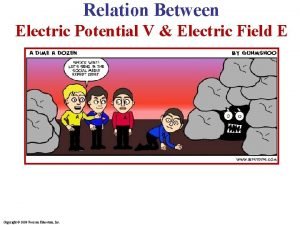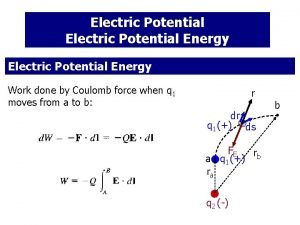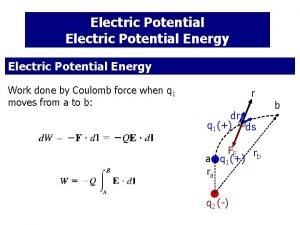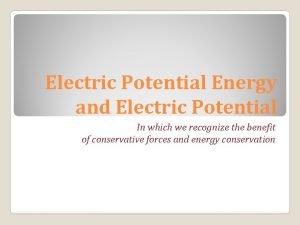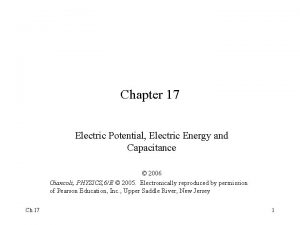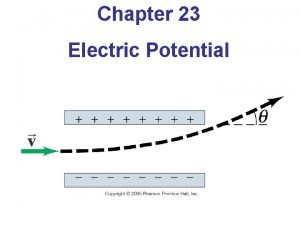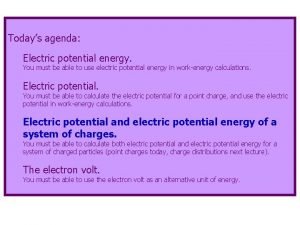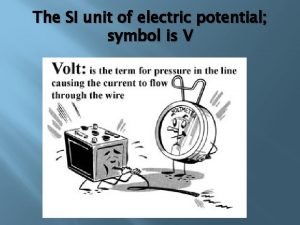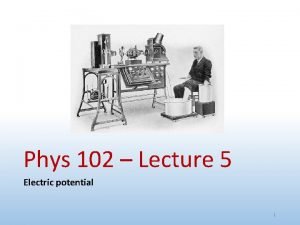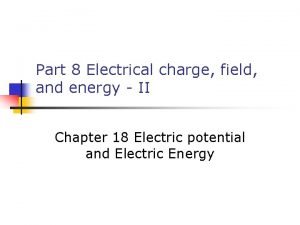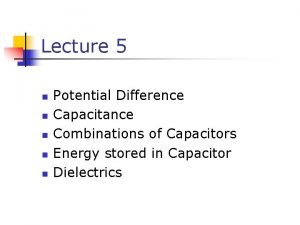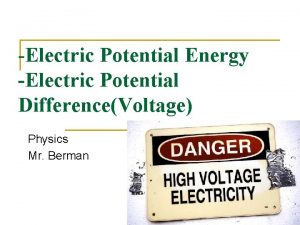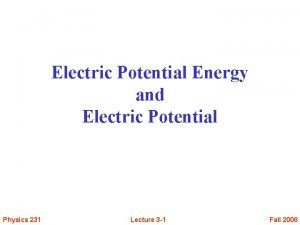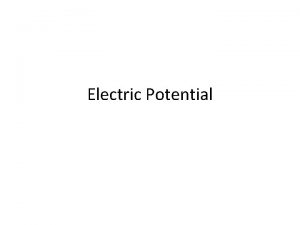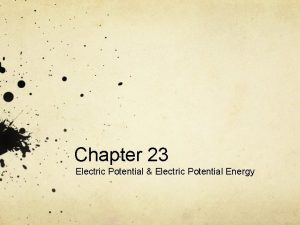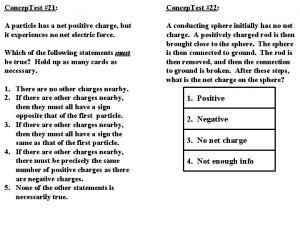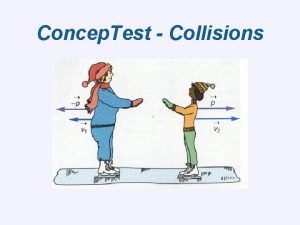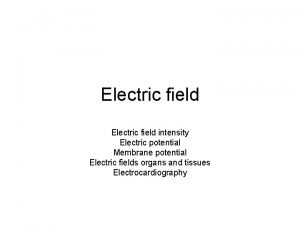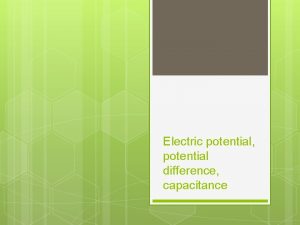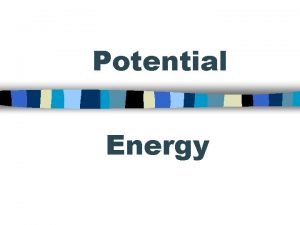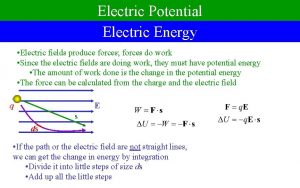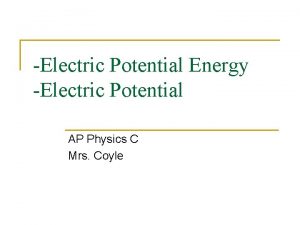Concep Test 16 1 a Electric Potential Energy








































- Slides: 40

Concep. Test 16. 1 a Electric Potential Energy I 1) proton A proton and an electron are in a constant electric field created by oppositely charged plates. You release the proton from the positive side and the electron from the negative side. Which feels the larger electric force? 2) electron 3) both feel the same force 4) neither–there is no force 5) they feel the same magnitude force but in opposite directions electron - + proton

Concep. Test 16. 1 a Electric Potential Energy I A proton and an electron are in a constant electric field created by oppositely charged plates. You release the proton from the positive side and the electron from the negative side. Which feels the larger electric force? 1) proton 2) electron 3) both feel the same force 4) neither–there is no force 5) they feel the same magnitude force but in opposite directions Since F = q. E and the proton and electron have the same charge in magnitude, magnitude they both experience the same force However, electron - the forces point in opposite directions because the proton and electron are oppositely charged + proton

Concep. Test 16. 1 b Electric Potential Energy II A proton and an electron are in a constant electric field created by oppositely charged plates. You release the proton from the positive side and the electron from the negative side. Which has the larger acceleration? 1) proton 2) electron 3) both feel the same acceleration 4) neither–there is no acceleration 5) they feel the same magnitude acceleration but in opposite directions electron - + proton

Concep. Test 16. 1 b Electric Potential Energy II A proton and an electron are in a constant electric field created by oppositely charged plates. You release the proton from the positive side and the electron from the negative side. Which has the larger acceleration? 1) proton 2) electron 3) both feel the same acceleration 4) neither–there is no acceleration 5) they feel the same magnitude acceleration but in opposite directions Since F = ma and the electron is much less electron - massive than the proton, then the electron experiences the larger acceleration + proton

Concep. Test 16. 1 c Electric Potential Energy III 1) proton A proton and an electron are in a constant electric field created by oppositely charged plates. You release the proton from the positive side and the electron from the negative side. When it strikes the opposite plate, which one has more KE? 2) electron 3) both acquire the same KE 4) neither – there is no change of KE 5) they both acquire the same KE but with opposite signs electron - + proton

Concep. Test 16. 1 c Electric Potential Energy III A proton and an electron are in a constant electric field created by oppositely charged plates. You release the proton from the positive side and the electron from the negative side. When it strikes the opposite plate, which one has more KE? 1) proton 2) electron 3) both acquire the same KE 4) neither – there is no change of KE 5) they both acquire the same KE but with opposite signs Since PE = q. V and the proton and electron have the same charge in magnitude, magnitude they both have the same electric potential energy initially. Because energy is conserved, they both must have the same kinetic energy after they reach the opposite plate. electron - + proton

Concep. Test 16. 2 Work and Potential Energy Which group of charges took more work to bring together from a very large initial distance apart? +2 d +1 +1 d +1 Both took the same amount of work d d +1

Concep. Test 16. 2 Work and Potential Energy Which group of charges took more work to bring together from a very large initial distance apart? +2 d +1 +1 Both took the same amount of work The work needed to assemble a collection of charges is the same as the total PE of those charges: added over all pairs d d +1 For case 1: only 1 pair For case 2: there are 3 pairs

Concep. Test 16. 3 a Electric Potential I 1) V > 0 What is the electric potential at point A? 2) V = 0 3) V < 0 A B

Concep. Test 16. 3 a Electric Potential I 1) V > 0 What is the electric potential at point A? 2) V = 0 3) V < 0 Since Q 2 (which is positive) positive is closer to point A than Q 1 (which is negative), and since the total potential is equal to V 1 + V 2, then the total potential is positive A B

Concep. Test 16. 3 b Electric Potential II 1) V > 0 What is the electric potential at point B? 2) V = 0 3) V < 0 A B

Concep. Test 16. 3 b Electric Potential II 1) V > 0 What is the electric potential at point B? 2) V = 0 3) V < 0 Since Q 2 and Q 1 are equidistant from point B, and since they have equal and opposite charges, then the total potential is zero Follow-up: What is the potential at the origin of the x-y axes? A B

Concep. Test 16. 4 Hollywood Square Four point charges are arranged at the corners of a square. Find the electric field E and the potential V at the center of the square. 1) E = 0 V=0 2) E = 0 V 0 3) E 0 V 0 4) E 0 V=0 5) E = V regardless of the value -Q +Q

Concep. Test 16. 4 Hollywood Square Four point charges are arranged at the corners of a square. Find the electric field E and the potential V at the center of the square. 1) E = 0 V=0 2) E = 0 V 0 3) E 0 V 0 4) E 0 V=0 5) E = V regardless of the value The potential is zero: zero the scalar contributions from the two positive charges cancel the two minus charges. However, the contributions from the electric field add up as vectors, and they do not cancel (so it is non-zero). non-zero Follow-up: What is the direction of the electric field at the center? -Q +Q

Concep. Test 16. 5 a Equipotential Surfaces I 1 At which point does V = 0? 5) all of them 2 +Q 3 4 –Q

Concep. Test 16. 5 a Equipotential Surfaces I 1 At which point does V = 0? 5) all of them 2 +Q 3 –Q 4 All of the points are equidistant from both charges Since the charges are equal and opposite, their contributions to the potential cancel out everywhere along the mid-plane between the charges. Follow-up: What is the direction of the electric field at all 4 points?

Concep. Test 16. 5 b Equipotential Surfaces II Which of these configurations gives V = 0 at all points on the x-axis? +2 m. C +1 m. C x -2 m. C -1 m. C 1) +2 m. C -2 m. C x -1 m. C 4) all of the above -2 m. C 2) x +1 m. C -1 m. C 3) 5) none of the above

Concep. Test 16. 5 b Equipotential Surfaces II Which of these configurations gives V = 0 at all points on the x-axis? +2 m. C +1 m. C x -2 m. C -1 m. C 1) +2 m. C -2 m. C x -1 m. C 4) all of the above -2 m. C 2) x +1 m. C -1 m. C 3) 5) none of the above Only in case (1), where opposite charges lie directly across the x-axis from each other, do the potentials from the two charges above the x-axis cancel the ones below the x-axis.

Concep. Test 16. 5 c Equipotential Surfaces III Which of these configurations gives V = 0 at all points on the y-axis? +2 m. C +1 m. C x -2 m. C -1 m. C 1) +2 m. C -2 m. C x -1 m. C 4) all of the above -2 m. C 2) x +1 m. C -1 m. C 3) 5) none of the above

Concep. Test 16. 5 c Equipotential Surfaces III Which of these configurations gives V = 0 at all points on the y-axis? +2 m. C +1 m. C x -2 m. C -1 m. C 1) +2 m. C -2 m. C x -1 m. C 4) all of the above -2 m. C 2) x +1 m. C -1 m. C 3) 5) none of the above Only in case (3), where opposite charges lie directly across the y-axis from each other, do the potentials from the two charges above the y-axis cancel the ones below the y-axis. Follow-up: Where is V = 0 for configuration 2?

Concep. Test 16. 6 Equipotential of Point Charge 1) A and C Which two points have the same potential? 2) B and E 3) B and D 4) C and E 5) no pair A C B E Q D

Concep. Test 16. 6 Equipotential of Point Charge 1) A and C Which two points have the same potential? 2) B and E 3) B and D 4) C and E 5) no pair Since the potential of a point charge is: A C only points that are at the same distance from charge Q are at the same potential This is true for points C and E. B They lie on an Equipotential Surface Follow-up: Which point has the smallest potential? E Q D

Concep. Test 16. 7 a Work and Electric Potential I 1) P 1 Which requires the most work, to move a positive charge from P to point 1, 2, 3 or 4 ? All points are the same distance from P. 2) P 2 3) P 3 4) P 4 5) all require the same amount of work 3 2 1 P 4

Concep. Test 16. 7 a Work and Electric Potential I Which requires the most work, to move a positive charge from P to point 1, 2, 3 or 4 ? All points are the same distance from P. For path 1, 1 you have to push the positive charge against the E field, which is hard to do. do By contrast, path #4 is the easiest, since the field does all the work. 1) P 1 2) P 2 3) P 3 4) P 4 5) all require the same amount of work 3 2 1 P 4

Concep. Test 16. 7 b Work and Electric Potential II 1) P 1 Which requires zero work, to move a positive charge from P to point 1, 2, 3 or 4 ? All points are the same distance from P. 2) P 2 3) P 3 4) P 4 5) all require the same amount of work 3 2 1 P 4

Concep. Test 16. 7 b Work and Electric Potential II Which requires zero work, to move a positive charge from P to point 1, 2, 3 or 4 ? All points are the same distance from P. 1) P 1 2) P 2 3) P 3 4) P 4 5) all require the same amount of work For path 3, 3 you are moving in a direction perpendicular to the field lines. This means you are moving along an equipotential, which requires no work (by definition). Follow-up: Which path requires the least work? 3 2 1 P 4

Concep. Test 16. 8 Capacitors Capacitor C 1 is connected across 1) C 1 a battery of 5 V. An identical 2) C 2 capacitor C 2 is connected across a battery of 10 V. Which one has the most charge? 3) both have the same charge 4) it depends on other factors

Concep. Test 16. 8 Capacitors Capacitor C 1 is connected across 1) C 1 a battery of 5 V. An identical 2) C 2 capacitor C 2 is connected across a battery of 10 V. Which one has the most charge? 3) both have the same charge 4) it depends on other factors Since Q = C V and the two capacitors are identical, the one that is connected to the greater voltage has the most charge, charge which is C 2 in this case.

Concep. Test 16. 9 a Varying Capacitance I What must be done to a 1) increase the area of the plates capacitor in order to 2) decrease separation between the plates increase the amount of 3) decrease the area of the plates charge it can hold (for 4) either (1) or (2) a constant voltage)? 5) either (2) or (3) +Q –Q

Concep. Test 16. 9 a Varying Capacitance I What must be done to a 1) increase the area of the plates capacitor in order to 2) decrease separation between the plates increase the amount of 3) decrease the area of the plates charge it can hold (for 4) either (1) or (2) a constant voltage)? 5) either (2) or (3) +Q –Q Since Q = C V, V in order to increase the charge that a capacitor can hold at constant voltage, one has to increase its capacitance Since the capacitance is given by , that can be done by either increasing A or decreasing d.

Concep. Test 16. 9 b Varying Capacitance II A parallel-plate capacitor 1) the voltage decreases initially has a voltage of 400 V 2) the voltage increases and stays connected to the 3) the charge decreases battery. If the plate spacing is now doubled, what happens? 4) the charge increases 5) both voltage and charge change +Q –Q

Concep. Test 16. 9 b Varying Capacitance II A parallel-plate capacitor 1) the voltage decreases initially has a voltage of 400 V 2) the voltage increases and stays connected to the 3) the charge decreases battery. If the plate spacing is now doubled, what happens? 4) the charge increases 5) both voltage and charge change Since the battery stays connected, the voltage must remain constant ! Since , when the spacing d is doubled the capacitance C is halved. And since Q = C V, V that means the charge must decrease Follow-up: How do you increase the charge? +Q –Q

Concep. Test 16. 9 c Varying Capacitance III A parallel-plate capacitor initially has a potential difference of 400 V and is then disconnected from the charging battery. If the plate spacing is now doubled (without changing Q), what is the new value of the voltage? +Q –Q 1) 100 V 2) 200 V 3) 400 V 4) 800 V 5) 1600 V

Concep. Test 16. 9 c Varying Capacitance III A parallel-plate capacitor initially has a potential difference of 400 V and is then disconnected from the charging battery. If the plate spacing is now doubled (without changing Q), what is the new value of the voltage? Once the battery is disconnected, Q has to remain constant, constant since no charge can flow either to or from the battery. Since , when the spacing d is doubled the capacitance C is halved. And since Q = C V, V that means the voltage must double 1) 100 V 2) 200 V 3) 400 V 4) 800 V 5) 1600 V +Q –Q

Concep. Test 16. 10 a Capacitors I 1) Ceq = 3/2 C What is the equivalent capacitance, 2) Ceq = 2/3 C Ceq , of the combination below? 3) Ceq = 3 C 4) Ceq = 1/3 C 5) Ceq = 1/2 C o Ceq o C C C

Concep. Test 16. 10 a Capacitors I 1) Ceq = 3/2 C What is the equivalent capacitance, 2) Ceq = 2/3 C Ceq , of the combination below? 3) Ceq = 3 C 4) Ceq = 1/3 C 5) Ceq = 1/2 C The 2 equal capacitors in series add o up as inverses, inverses giving 1/2 C. These are parallel to the first one, which add up directly Thus, the total equivalent capacitance is 3/2 C. Ceq o C C C

Concep. Test 16. 10 b Capacitors II How does the voltage V 1 across 1) V 1 = V 2 the first capacitor (C 1) compare 2) V 1 > V 2 to the voltage V 2 across the 3) V 1 < V 2 second capacitor (C 2)? 4) all voltages are zero C 2 = 1. 0 m. F 10 V C 1 = 1. 0 m. F C 3 = 1. 0 m. F

Concep. Test 16. 10 b Capacitors II How does the voltage V 1 across 1) V 1 = V 2 the first capacitor (C 1) compare 2) V 1 > V 2 to the voltage V 2 across the 3) V 1 < V 2 second capacitor (C 2)? 4) all voltages are zero The voltage across C 1 is 10 V. The combined capacitors C 2+C 3 are parallel to C 1. The voltage across C 2+C 3 is also 10 V. Since C 2 and C 3 are in series, their voltages add. Thus the voltage across C 2 and C 3 each has to be 5 V, which is less than V 1. C 2 = 1. 0 m. F 10 V C 1 = 1. 0 m. F C 3 = 1. 0 m. F Follow-up: What is the current in this circuit?

Concep. Test 16. 10 c How does the charge Q 1 on the first capacitor (C 1) compare to the charge Q 2 on the second capacitor (C 2)? Capacitors III 1) Q 1 = Q 2 2) Q 1 > Q 2 3) Q 1 < Q 2 4) all charges are zero C 2 = 1. 0 m. F 10 V C 1 = 1. 0 m. F C 3 = 1. 0 m. F

Concep. Test 16. 10 c How does the charge Q 1 on the first capacitor (C 1) compare to the charge Q 2 on the second capacitor (C 2)? Capacitors III 1) Q 1 = Q 2 2) Q 1 > Q 2 3) Q 1 < Q 2 4) all charges are zero We already know that the C 2 = 1. 0 m. F voltage across C 1 is 10 V and the voltage across both C 2 and C 3 is 5 V each. Since Q = CV and C is the same for all the capacitors, then since V 1 > V 2 therefore Q 1 > Q 2. 10 V C 1 = 1. 0 m. F C 3 = 1. 0 m. F
 Electric field lines
Electric field lines Potential unit
Potential unit Electric potential and potential energy
Electric potential and potential energy Sa bawat concept map
Sa bawat concept map Define electric potential and potential difference.
Define electric potential and potential difference. Electric potential
Electric potential Potential energy due to point charges
Potential energy due to point charges Energy electric field
Energy electric field Electric potential is
Electric potential is What is the relation between e and v
What is the relation between e and v Work done by coulomb force
Work done by coulomb force Work done by coulomb force
Work done by coulomb force Electric potential
Electric potential Absolute potential energy
Absolute potential energy Electric potential energy of capacitor
Electric potential energy of capacitor Potential energy of capacitor
Potential energy of capacitor Relation between potential energy and electric field
Relation between potential energy and electric field Electric potential energy
Electric potential energy Symbol for electric potential
Symbol for electric potential Electric potential energy
Electric potential energy Electric potential energy
Electric potential energy Electric potential
Electric potential Gpe= mgh
Gpe= mgh V=ed physics
V=ed physics Electric potential energy definition
Electric potential energy definition Is mechanical energy potential or kinetic
Is mechanical energy potential or kinetic Elastic potential energy examples
Elastic potential energy examples Examples of mechanical energy
Examples of mechanical energy Gravitational potential energy vs kinetic energy
Gravitational potential energy vs kinetic energy Potential energy vs kinetic energy
Potential energy vs kinetic energy Kinetic energy examples
Kinetic energy examples Types of potential energy
Types of potential energy Gravitational potential energy
Gravitational potential energy Conservation of mechanical energy
Conservation of mechanical energy Osmotic potential vs water potential
Osmotic potential vs water potential Water potential and osmotic potential
Water potential and osmotic potential Water potential definition
Water potential definition Neuronal pool
Neuronal pool Graded potential and action potential
Graded potential and action potential Graded vs action potential
Graded vs action potential Action potential definition
Action potential definition









